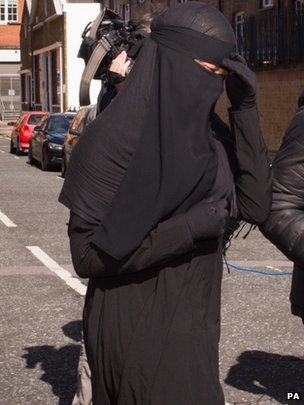The specter of a person testifying with her face obscured by a religious covering has reached a lower court in the UK, with Judge Peter Murphy rendering his 36 page opinion in Queen v. D (R).
On this side of the Atlantic, the Supreme Court of Canada ruled earlier this year in R. v. N.S. that the decision whether or not to allow the witness to wear her niqab was one that should largely be left to the trial judge, weighing various factors that supply guidance. Importantly (especially for dissenting Justice Abella), N.S. involved a sexual assault prosecution by the young woman wearing the niqab in which the defendants were members of her own family. Although Judge Murphy relies upon N.S., he also distinguishes it.
In the U.K. case, D is the defendant, on trial for “a single count of witness intimidation,” and there is no issue of identification. Judge Murphy makes clear that his judgment focuses upon D’s role as a defendant in a Crown prosecution. He acknowledges that D possesses religious rights:
The defendant has the qualified right to manifest her religion or belief pursuant to art. 9 of the European Convention on Human Rights (‘the Convention’). By virtue of the Human Rights Act 1998, that right is cognisable as a matter of domestic law in the Crown Court. By virtue of s.6(1) and (3) of that Act, the Court is a public authority and may not act in a way incompatible with a Convention right. At the same time, the Court may be entitled to place restrictions on a qualified Convention right, such as that under art. 9.
The judge accorded sincerity to D’s belief, but did devote some discussion on whether or not the belief was mandated, and he also discusses the “positive benefits” of the niqab and views it as consistent with participation in a democratic society. As to D’s defendant status, the judge opined that fairness as to her was not the only – – – or perhaps even primary – – – consideration: the victims, the members of the jury, and public at large are also important.
But like the Supreme Court of Canada suggested in N.S. for the trial judge on remand, essentially Judge Murphy balances the equities. For Judge Murphy, D has choices: how to dress and whether to give evidence. Indeed, Murphy considers dress untethered to religion. In paragraph 73 he writes:
It is rare for the defendant’s manner of dress to be an issue in the conduct of judicial business. Today, the Courts are rightly tolerant of informality or diversity of dress on the part of defendants, witnesses, and jurors. But a defendant’s dress may become an issue. For example, the defendant’s choice of dress may invoke the rules of bad character evidence if, unless corrected, it would give the jury a false impression, for example if the defendant appears at court wearing a clerical collar or military uniform: see Criminal Justice Act 2003, s.101(1)(f). If a defendant were to appear wearing a t-shirt with an obscene, racist, or offensive logo, it cannot be doubted that the Court would be entitled to take steps to protect the dignity of the proceedings. And it the defendant’s dress interferes to an unacceptable degree with the Court’s ability to conduct a trial which is fair to all parties, the Court may similarly have to take action to ensure that the trial can proceed in the manner prescribed by law, and is fair to all parties.
Given the “choice” as to dress, the other choice regarding the giving of evidence (testimony) constitutes the other side of Judge Murphy’s equation. He rules that should she chose to give evidence, then she must not be wearing the niqab, although she “may give evidence from behind a screen shielding her from public view, but not from the view of the judge, the jury, and counsel; or by mean of a live TV link.” The judge further ordered that there be no sketching or drawing of D (filming is already prohibited).
For those in the US, it is only a matter of time before this issue will be presented before courts as squarely as in the UK’s Queen v. D and Canada’s R. v. N.S. To date, there have been several courts that have considered the issue of a veiled witness, including a small claims judge resulting in a reconsideration of the evidentiary rules as is discussed in Chapter 6 of Dressing Constitutionally. If American jurists look to their colleagues outside The States, these are both important and well-reasoned decisions, even if one disagrees with their conclusions. More about the case is on Constitutional Law Professors Blog here.
[image via]

